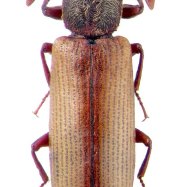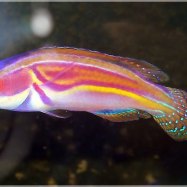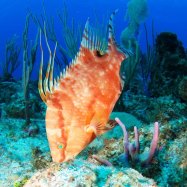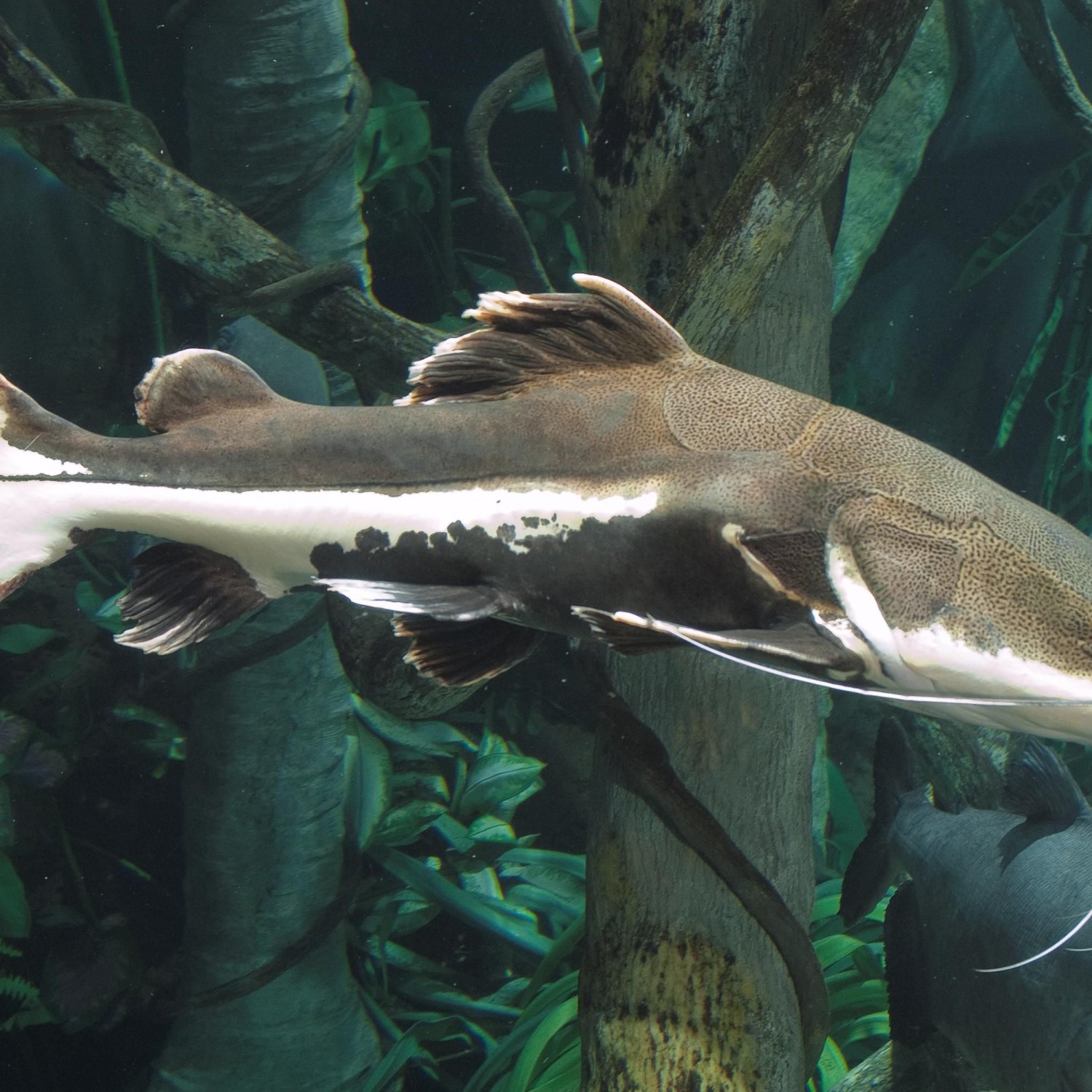
Redtail Catfish
Up to 5 feet (1.5 meters)
Did you know that the Redtail Catfish can reach lengths of up to 5 feet? This impressive fish is native to the Amazon River Basin and belongs to the Pimelodidae family. Its elongated and cylindrical body shape allows it to swim effortlessly through the water. Have you ever seen one in person? #redtailcatfish #amazonriver #fascinatingfish
Animal Details Summary:
Common Name: Redtail Catfish
Kingdom: Animalia
Habitat: Freshwater
The Majestic Redtail Catfish: A Jewel of the Amazon River Basin
The Amazon River Basin, with its diverse ecosystem and vibrant wildlife, is a treasure trove for nature enthusiasts. It is home to some of the most fascinating and unique creatures on the planet, including the striking Redtail Catfish. With its dark gray or black body and a vibrant red tail, this fish is truly a jewel of the Amazon.Scientifically known as Phractocephalus hemioliopterus, the Redtail Catfish belongs to the order Siluriformes, commonly known as catfish Redtail Catfish. It is part of the Pimelodidae family and is closely related to other catfish species like the Tiger Shovelnose catfish and the Jau catfish. It is endemic to the freshwater bodies of South America, making Brazil its country of origin.
This magnificent fish has captured the fascination of many and is becoming increasingly popular among fish enthusiasts. In this article, we will dive deeper into the world of the Redtail Catfish, exploring its habitat, behavior, and unique features.
The Habitat of the Redtail Catfish
The Redtail Catfish, like many other catfish species, is found in freshwater bodies. It is most commonly found in the Amazon River Basin, especially in the flooded rainforests during the rainy season. The rainforest is the perfect environment for this fish as it provides ample hiding spots, abundant food, and suitable breeding grounds.
Within the Amazon, the Redtail Catfish can be found in various types of freshwater bodies, including rivers, streams, lakes, and ponds. They are particularly fond of slow-moving waters with plenty of submerged vegetation, rocks, and tree roots River Otter. These areas provide the ideal hiding and hunting spots for these fish.
Did you know? The Redtail Catfish is also sometimes found in the aquarium trade, but it requires large tanks and specialized care due to its size and unique behavior.
The Carnivorous Nature of the Redtail Catfish
The Redtail Catfish is a carnivorous fish, which means it primarily feeds on meat. In the wild, it is an opportunistic feeder, meaning it will eat whatever is available and within its reach. Its diet consists mainly of smaller fishes, crustaceans, snails, and insects.
In captivity, the Redtail Catfish is usually fed a variety of fish pellets, shrimp, and occasionally live fish or insects. Due to its large size, it requires a significant amount of food, and owners must take great care to ensure a balanced and nutritious diet to keep their fish healthy.
- Feeding Tip: It is essential to regulate the feeding schedule and amount of food given to the Redtail Catfish as overfeeding can lead to obesity and other health issues.
- Another interesting fact is that Redtail Catfish have taste buds all over their bodies, making them very sensitive to touch and helping them find food even in the darkest waters.
Geographical Distribution and Country of Origin
As mentioned earlier, the Redtail Catfish is endemic to South America, with its main distribution area being the Amazon River Basin. This vast region covers over 4 million square kilometers and spans across eight countries, including Brazil, Peru, Colombia, Bolivia, and Ecuador.
Among these, Brazil is considered the country of origin for the Redtail Catfish, with the largest populations found in its waters. The Amazon River and its tributaries, including the Rio Negro, Rio Madeira, and the Rio Tocantins, are some of the places where this fish is most commonly found.
Unique Features of the Redtail Catfish
Apart from its striking coloration, the Redtail Catfish is known for its elongated and cylindrical body shape, which is ideal for navigating through the murky waters of the Amazon. Its body is covered with small, rough scales that protect it from potential predators.
Further distinguishing features of the Redtail Catfish include its long barbels, which resemble whiskers, and its large, flattened head. These barbels serve as sensory organs, helping the fish locate food and navigate through its environment.
One of the most remarkable features of the Redtail Catfish is its size. It can grow up to 5 feet (1.5 meters) in length, making it one of the largest freshwater fish in South America. In captivity, it can reach up to 2-3 feet (60-90 cm), but this still makes it a challenging species to keep as a pet.
Reproduction and Behavior
Redtail Catfish reach sexual maturity between 2-3 years of age. During the breeding season, which usually occurs during the rainy season, the female lays hundreds of eggs, which are then fertilized by the male fish. These eggs are then guarded and protected by both parents.
The Redtail Catfish is a nocturnal fish and is mostly active at night. During the day, it tends to hide under rocks or tree roots to avoid predators and conserve energy. It is an elusive and solitary creature, and its coloring makes it an effective ambush predator, waiting for smaller fish to come within its reach.
In Conclusion
The Redtail Catfish is a prime example of the diverse and unique wildlife found in the Amazon River Basin. Its striking red tail, impressive size, and carnivorous nature make it a fascinating fish for both nature enthusiasts and fish keepers alike.Although this fish is currently classified as least concern on the IUCN Red List, its population is facing threats such as habitat destruction, overfishing, and pollution. It is crucial to protect and preserve its natural habitat to ensure the survival of this beautiful species for generations to come.
So the next time you're exploring the Amazon, keep an eye out for the majestic Redtail Catfish, and marvel at the wonders of nature.

Redtail Catfish
Animal Details Redtail Catfish - Scientific Name: Phractocephalus hemioliopterus
- Category: Animals R
- Scientific Name: Phractocephalus hemioliopterus
- Common Name: Redtail Catfish
- Kingdom: Animalia
- Phylum: Chordata
- Class: Actinopterygii
- Order: Siluriformes
- Family: Pimelodidae
- Habitat: Freshwater
- Feeding Method: Carnivorous
- Geographical Distribution: South America
- Country of Origin: Brazil
- Location: Amazon River Basin
- Animal Coloration: Dark gray or black body with a distinct red tail
- Body Shape: Elongated and cylindrical
- Length: Up to 5 feet (1.5 meters)
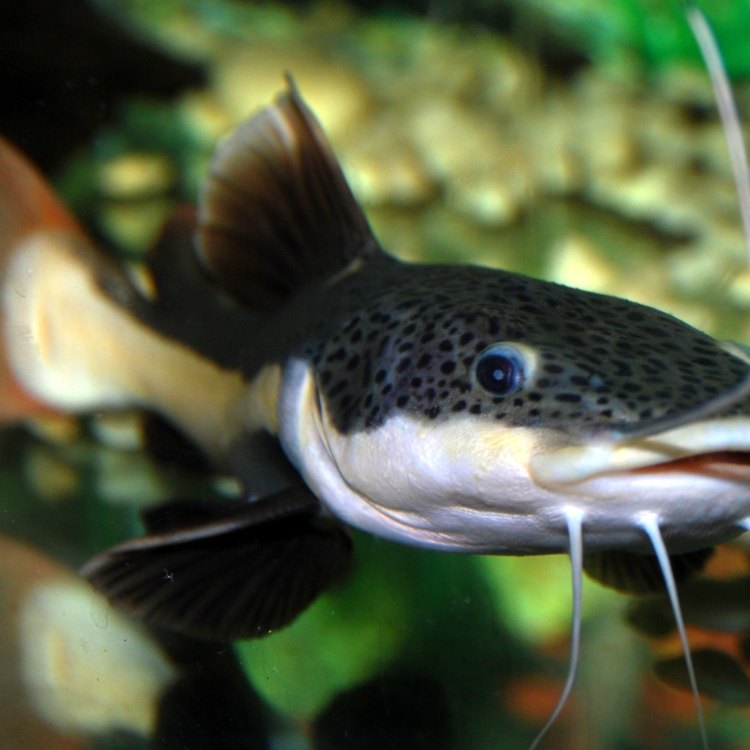
Redtail Catfish
- Adult Size: Large
- Average Lifespan: Up to 20 years
- Reproduction: Sexual
- Reproductive Behavior: The male guards the eggs and fry
- Sound or Call:
- Migration Pattern: No specific migration pattern
- Social Groups: Solitary
- Behavior: Nocturnal
- Threats: Overfishing, habitat destruction, and pollution
- Conservation Status: Not evaluated
- Impact on Ecosystem: Top predator, helps maintain balance in the ecosystem
- Human Use: Popular in the aquarium trade
- Distinctive Features: Large red tail, whisker-like structures on the face
- Interesting Facts: Redtail catfish have strong teeth and can inflict serious injuries if mishandled
- Predator: Bigger fish and other predators
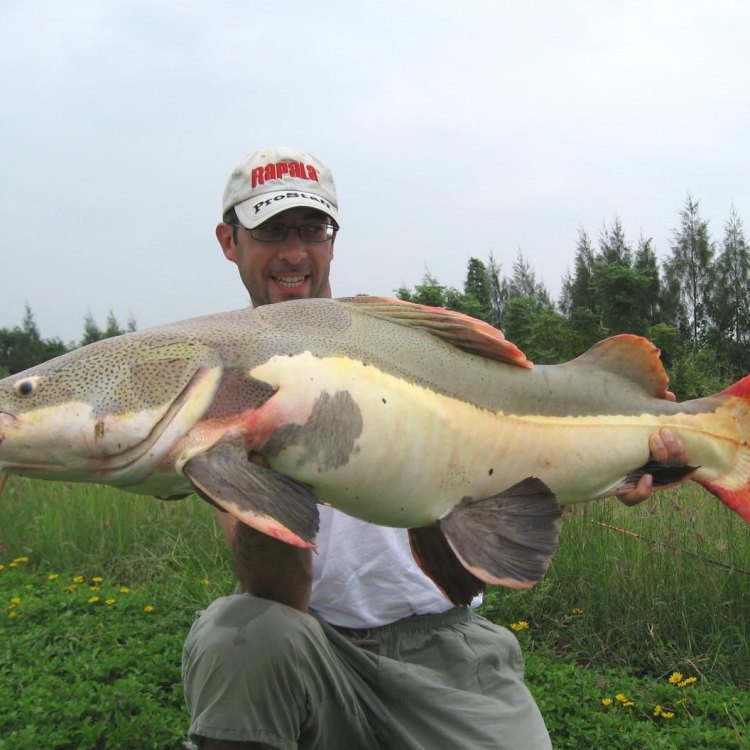
Phractocephalus hemioliopterus
The Mysterious and Majestic Redtail Catfish: Unveiling Its Unique Features, Behavior, and Impact on the Ecosystem
The Amazon rainforest is filled with an abundance of fascinating and diverse aquatic life, and among them is the magnificent Redtail Catfish. Named for its distinct vibrant red tail, this species is one of the largest freshwater fish found in the Amazon basin. But what makes this fish so unique? From its intriguing behavior to its crucial role in the ecosystem, let's take a closer look at this mysterious and majestic creature.Adult Size: Large
The Redtail Catfish, scientifically known as Phractocephalus hemioliopterus, has an average adult size of 3-5 feet and can weigh up to a whopping 100 pounds! Its massive size makes it a force to be reckoned with in the Amazon rivers, where it dominates as the top predator PeaceOfAnimals.Com. The juveniles, however, have a different appearance, with a slender, dark-colored body and white spots all over, making them easy prey for larger predators.
Average Lifespan: Up to 20 years
Despite being a popular choice in the aquarium trade, the Redtail Catfish can live up to 20 years in the wild. This longevity is due to its hardy nature and adaptability to different environments. In captivity, with proper care and a suitable tank size, they can live just as long.
Reproduction: Sexual
The Redtail Catfish reproduces through sexual reproduction, with males and females coming together to breed. The mating process involves the males guarding the eggs and the newly hatched fry until they are old enough to fend for themselves. This behavior is vital for the survival of the species, as it ensures the safety and protection of the younger generation.
Reproductive Behavior: The male guards the eggs and fry
During the breeding season, the male Redtail Catfish takes on the role of a dedicated protector. He guards the eggs and fry, fanning them with his fins to provide them with oxygen and ensuring they are free from predators Robber Flies. This behavior is a testament to the strong parental instincts of this species, making it a fascinating subject of study for researchers.
Nocturnal Behavior
During the day, the Redtail Catfish prefers to stay hidden in the murky waters of the Amazon. But as the sun sets and darkness falls, it becomes an active and skilled nocturnal hunter. With its keen sense of smell, it can locate prey in the darkness, relying on its whisker-like structures on its face to sense vibrations in the water.
No specific migration pattern
Unlike other migratory fish, the Redtail Catfish does not have a specific migration pattern. Instead, it stays in one area, exploring different parts of the river as it grows older. This behavior allows it to become familiar with the surroundings, making it a highly efficient hunter.
Solitary Social Groups
The Redtail Catfish is mostly a solitary creature, preferring to roam and hunt alone. This behavior could also be attributed to its sheer size, making it harder to find suitable companions. However, juveniles can sometimes be found in small groups, but as they grow bigger, they tend to become more solitary.
Threats: Overfishing, habitat destruction, and pollution
Unfortunately, the Redtail Catfish, like many other aquatic creatures, faces various threats, including overfishing, habitat destruction, and pollution. These factors have led to a decline in their population, raising concerns about their survival in the wild. Due to its size and popularity in the aquarium trade, the Redtail Catfish is also at risk of being overexploited, which could result in a significant impact on its presence in the ecosystem.
Conservation Status: Not evaluated
Despite being a popular fish, the Redtail Catfish is not listed on the International Union for Conservation of Nature (IUCN) Red List, mainly due to a lack of proper data and information. Further research and monitoring of their population and threats are needed to assess their conservation status accurately.
Impact on Ecosystem
As the top predator in the Amazon rivers, the Redtail Catfish plays a crucial role in maintaining a balance in the ecosystem. Its presence helps regulate the population of other fish and prevents them from overpopulating and depleting resources. By targeting weaker or sick individuals, the Redtail Catfish also helps in keeping the river healthy and free from diseases, making it a vital contributor to the overall health of the ecosystem.
Human Use: Popular in the aquarium trade
With its striking appearance and adaptability, the Redtail Catfish has become a popular choice in the aquarium trade. However, before adding one to your tank, it's crucial to consider the size and space requirements, as well as the potential impact on the wild population. Inappropriate tank sizes and overexploitation could have serious consequences for this species, its ecosystem, and the Amazon rainforest as a whole.
Distinctive Features: Large red tail, whisker-like structures on the face
The most striking feature of the Redtail Catfish is, without a doubt, its vibrant red tail. This distinct feature makes it easy to spot in the murky waters of the Amazon and also serves as a defense mechanism, startling predators when threatened. Additionally, the whisker-like structures on its face, known as barbels, help it navigate through the river and sense its prey, making it a skilled hunter.
Interesting Facts
Apart from its impressive size, the Redtail Catfish also has some interesting facts that set it apart from other freshwater fish. For instance, this species has strong teeth and can inflict serious injuries if mishandled, making it important to handle them with caution. They also have a habit of consuming air, which is essential for their digestion, making it necessary to provide them with suitable hiding spaces in their tanks.
Predator: Bigger fish and other predators
Although the Redtail Catfish is the top predator in the Amazon rivers, it is not immune to other predators. Larger fish such as piranhas and stingrays, as well as crocodiles and birds, are a constant threat. In some cases, humans have also hunted them for their meat and skin, posing an additional threat to their survival.
In conclusion, the Redtail Catfish is truly a remarkable and unique creature, with its impressive size, fascinating behavior, and important role in the ecosystem. As we continue to explore and learn more about the Amazon rainforest, it is crucial to remember to preserve and protect its diverse aquatic life, including the majestic Redtail Catfish, for future generations to admire and appreciate.

The Majestic Redtail Catfish: A Jewel of the Amazon River Basin
Disclaimer: The content provided is for informational purposes only. We cannot guarantee the accuracy of the information on this page 100%. All information provided here may change without prior notice.





